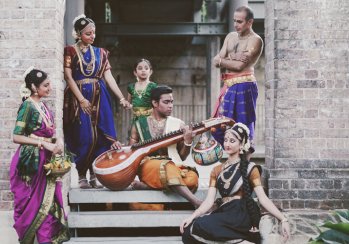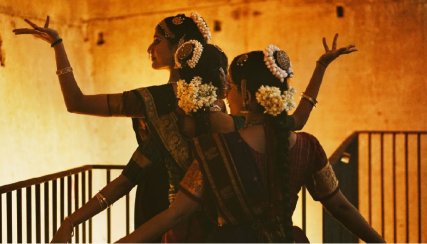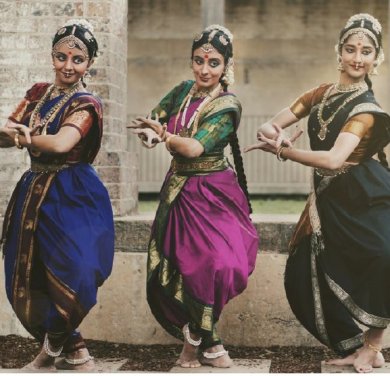
|   |

|   |
Agal's tribute to Balasaraswati - Kalpana Ram e-mail: kalpana.ram@mq.edu.au Images courtesy: Dioscuri and Fotominded December 10, 2018 Sanctum, a homage to Balamma, was presented by Shri Nrityam and curated by Vishnu Arunasalam, Artistic Director of Agal Dance Company. Agal is a dance company that is young in many senses of the word: it is new, the dancers are young and full of vibrant energy, and what I witnessed at the launch of the company was also fresh since it was a tribute to the great Balasaraswati on the occasion of her centenary. I had done much reading on the distinctive features of Bala's dance style, but rarely been privileged to see it with my own eyes. I was keen to see if the dancers were able to handle Bala's distinctive contribution to keeping alive to some extent the very elements that twentieth century reformers had judged to be undesirable as they went about re-crafting the tradition into what is now called Bharatanatyam. Chief among the elements that had to be excised, according to reformers, was the recognition that the custodians of our rich aesthetic traditions in southern India were in fact none other than the dancers and musicians of the devadasi communities who performed at the Thanjavur courts in the eighteenth and nineteenth centuries. The community became stigmatised by modernising elites and described as having slipped into a decadent decline into prostitution, but Balasaraswati, who descended and was trained in this lineage, resolutely refused to be forced into shame over her tradition, and sought instead to pass it on through her teaching which she eventually took to the United States where she taught till the end of her life. Paradoxically, then, there are more exponents of her style in the U.S than there are in her native Tamil Nadu. Nor did she see any need to suppress the erotic content of many of the padams performed by devadasis, instead seeing it as an integral aspect of human experience, as well as belonging to the time honoured traditions in India which repeatedly fused the erotic and the spiritual, both in the bhakti mode and in the sufi traditions which took deep root in India. Some of the dancers of Agal received their training in the Kalaksehtra tradition pioneered by the reformer Rukmini Devi. More than any other reformer, it was Rukmini Devi who moved to expunge or minimise the erotic, steering the dance away from the leisurely improvisatory exploration by the individual female dancer who used abhinaya as a central feature of expressivity, in favour of newly choreographed ensemble pieces with many dancers, who would enact specific roles and events. It is Kalakshetra's tradition that has become the dominant signature of Bharatanatyam. The challenge for the dancers in Agal was therefore technical - given the way in which rigorous training becomes a part of the muscle memory of dancers, how were they going to dance in Bala's style? The challenge was and is also cultural: how do modern dancers embrace the distinctiveness of a legacy that continues to be covered in stigma, such that even an established poet in Chennai speaking at a major dance conference could be pilloried in January 2018 for daring to even juxtapose the term devadasi with reference to a revered figure such as Andal. In other words it would take young people a lot of courage in today's climate to break from such stifling dogma. What I saw was heartening indeed. The dancers dispensed with the Bharatanatyam costumes devised by Rukmini Devi in favour of the sari worn in a way that allows movement and grace with no sacrifice of modesty, despite the absence of the 'fan' between the legs introduced by Rukmini Devi. Indeed, as the mother of one of the dancers readily confided to me after the show, it is this fan over the breasts and legs of women that even more conspicuously draw attention to the 'forbidden' areas it seeks to cover. Whereas the sari, as Bala and her mother wore it in dance, is beautiful in its simplicity as well as in its continuity with the sari as worn by women in everyday life as they go about their work, with the pallu tucked out of the way, into the waistband.   The structure of the performance tried to follow the margam as advocated by Bala: alarippu or invocation, followed by the varnam, thence to padams and javalis, and concluding with a vigorous tillana. In a memorable Presidential Address to the Tamil Isai Sangam in 1975 that was subsequently translated into English and published, Bala movingly describes the movement of the dancer through these items as the movement of a worshipper through the great temples of the south. One moves from clearly visible rhythmic figures carved on the gopuram, through to the expansive sense one has in the presence of the deity in the varnam, to the cool quiet intimacy of the inner sanctum where the padams explore that sense of intimate emotions of longing and union, to relish at the end the joy of pure rhythm of the tillana. Like all the great art of India, the spectator is not separated or an onlooker to this movement - she too participates in the rasa, the taste and savouring of all that is enacted. As a result of following Bala's wonderful vision, guests were treated to a movement from the cold winter Australian streets of Paramatta into an inner sunlit courtyard at the heritage home of Gokulan Gopal where we could already hear the ringing tones of Vishnu Arunasalam calling out the nattuvangam for the Tisra Alarippu. This was followed by Vishni Ravindran performing "Ksheera Sagara Shayana," which the dancers saw as the first vision of the divine image by the worshipper in the temple. Talking to Vishni after the show I found her to be exemplary of the kind of talented young people of Indian heritage who we have in Australia now. She is working hard at a medical degree while ardently pursuing dance over the years - learned the hard way, resorting to Skype when trips to Chennai are not possible. Two of the pieces, the javali and the padam stood out for their frank exploration, not simply of sexuality, but sexuality from a female perspective. The pieces certainly explore love, but they also contain implicit and even explicit criticism of patriarchal norms. The padam "Mogudochi" performed by Shobhana Suresh was moving for this reason. The young girl looks for her lover, not in longing alone, but bowed by grief at the prospect of a pre-pubertal marriage catching up with her. An event she scarcely recalls is now back to claim her very life - she is to be taken away in the morning by her husband who is nothing more than a stranger to her. She tells her lover she will never forget him, but in appealing to him to keep her in his heart, there is a sense in which the spectator is left uneasily aware that she feels this relationship may quite possibly be far more central to her than it is to her lover. The fact that the lover is Krishna scarcely reassures, given his dalliances with gopis! Nor does the divinisation of the hero alter the unconventional nature of the piece, which contains both premarital love as well as the grief of a young woman at patriarchal ways of disposing of her life. The javali was equally remarkable. "Ithu Sahasamulu," composed by Swathi Tirunal features a young devadasi who tells an older man she likes his company and looks forward to a time when she will be ready for a sexual relationship but tells him frankly, and repeatedly through the many moves of a dancer in an interpretive piece, that she is not ready for him. She is young, she says, and her body is not ready for a pre-pubertal relationship. He needs to learn patience and other forms of love in the meantime, for what she wants is tenderness and companionship while she matures in his love.  The piece potentially sheds a fresh angle on the young women of the devadasi community who came to be represented by the reform movement as sexual slaves and victims, a prelude to having a law passed in 1947 prohibiting older women from initiating their young daughters into both art and potential sexual relationships. Devadasis did not see themselves in such a degraded light. As they complained at the time, the passing of such an act, which deprived them of their livelihood, would most certainly ensure that they became the prostitutes they were already accused of being. Sexuality was neither shunned by the women nor did they see themselves as victims exercising no agency in the way relationships were conducted. And this is exactly the sensibility the young woman in the javali conveys. The fact that an elite man composed the piece actually strengthens our sense of the texture of relationships between elite men and devadasis. It is ironic that devadasis have borne the opprobrium of prostitution but not their male patrons. I have not researched into whether Swathi Tirunal actually had liaisons with devadasis, but he certainly had them brought from Tanjavur to his court in Travancore to enhance his court and to learn further from their deep knowledge of aesthetics. My central point is, however, not to say that men were as guilty as women, which they were of course if we are to frame the matter in terms of guilt, but rather that neither were the patrons necessarily exploitative nor were the women necessarily victims. Many of the exquisite music compositions that the women interpreted through their dance and theatre were loving tributes composed specifically for them by their elite and often talented lovers. In stigmatising the entire devadasi community we have also lost access to the texture of the social relations that nurtured artistic culture for centuries. And if we view the two pieces, the Padam "Mogudochi" and the javali in a relationship with one another, then we have to confront the fact that the gulf between the victimhood of the devadasi and the freedom of the bride is not as great as we like to imagine. The javali was performed by M. T. Shriram, the youthful director of another dance company based in Melbourne, Shri Nrityam. And here was another remarkable feature of the performance: when he first came on stage I am sure I was not alone in wondering how a young man with very short hair was going to make me participate in the spirit and embodiment of a young devadasi girl. It is entirely a tribute to him that I simply ceased to be caught up by such thoughts - like all true artists, he made us see and imagine what he performed. All dancers joined in the Tillana. As in the piece individually danced by Chidambaram R Suresh, the training of Kalakshetra was now very visible in the attention to technique and precision as well as the ensemble style of dancing. Although this has been developed at the expense of Bala's expressivity, that afternoon we had both styles represented, and it showed how rich it would be to open up the repertoire to more than one tradition. Associate Professor Kalpana Ram has taught Anthropology at Macquarie University for many years and has international recognition for her work on India in the fields of gender relations, working with women in Dalit and fishing communities in Tamil Nadu. She has also published on dance and music in relation to Indian modernity, gender and nationalism. |